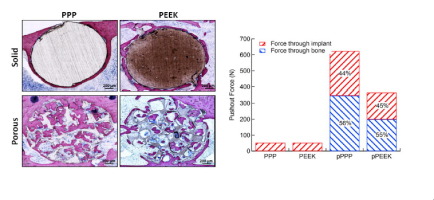Acta Biomaterialia ( IF 9.7 ) Pub Date : 2018-03-18 , DOI: 10.1016/j.actbio.2018.03.025 Hyunhee Ahn , Ravi R. Patel , Anthony J. Hoyt , Angela S.P. Lin , F. Brennan Torstrick , Robert E. Guldberg , Carl P. Frick , R. Dana Carpenter , Christopher M. Yakacki , Nick J. Willett

|
Poly(para-phenylene) (PPP) is a novel aromatic polymer with higher strength and stiffness than polyetheretherketone (PEEK), the gold standard material for polymeric load-bearing orthopaedic implants. The amorphous structure of PPP makes it relatively straightforward to manufacture different architectures, while maintaining mechanical properties. PPP is promising as a potential orthopaedic material; however, the biocompatibility and osseointegration have not been well investigated. The objective of this study was to evaluate biological and mechanical behavior of PPP, with or without porosity, in comparison to PEEK. We examined four specific constructs: 1) solid PPP, 2) solid PEEK, 3) porous PPP and 4) porous PEEK. Pre-osteoblasts (MC3T3) exhibited similar cell proliferation among the materials. Osteogenic potential was significantly increased in the porous PPP scaffold as assessed by ALP activity and calcium mineralization. In vivo osseointegration was assessed by implanting the cylindrical materials into a defect in the metaphysis region of rat tibiae. Significantly more mineral ingrowth was observed in both porous scaffolds compared to the solid scaffolds, and porous PPP had a further increase compared to porous PEEK. Additionally, porous PPP implants showed bone formation throughout the porous structure when observed via histology. A computational simulation of mechanical push-out strength showed approximately 50% higher interfacial strength in the porous PPP implants compared to the porous PEEK implants and similar stress dissipation. These data demonstrate the potential utility of PPP for orthopaedic applications and show improved osseointegration when compared to the currently available polymeric material.
Statement of Significance
PEEK has been widely used in orthopaedic surgery; however, the ability to utilize PEEK for advanced fabrication methods, such as 3D printing and tailored porosity, remain challenging. We present a promising new orthopaedic biomaterial, Poly(para-phenylene) (PPP), which is a novel class of aromatic polymers with higher strength and stiffness than polyetheretherketone (PEEK). PPP has exceptional mechanical strength and stiffness due to its repeating aromatic rings that provide strong anti-rotational biaryl bonds. Furthermore, PPP has an amorphous structure making it relatively easier to manufacture (via molding or solvent-casting techniques) into different geometries with and without porosity. This ability to manufacture different architectures and use different processes while maintaining mechanical properties makes PPP a very promising potential orthopaedic biomaterial which may allow for closer matching of mechanical properties between the host bone tissue while also allowing for enhanced osseointegration. In this manuscript, we look at the potential of porous and solid PPP in comparison to PEEK. We measured the mechanical properties of PPP and PEEK scaffolds, tested these scaffolds in vitro for osteocompatibility with MC3T3 cells, and then tested the osseointegration and subsequent functional integration in vivo in a metaphyseal drill hole model in rat tibia. We found that PPP permits cell adhesion, growth, and mineralization in vitro. In vivo it was found that porous PPP significantly enhanced mineralization into the construct and increased the mechanical strength required to push out the scaffold in comparison to PEEK. This is the first study to investigate the performance of PPP as an orthopaedic biomaterial in vivo. PPP is an attractive material for orthopaedic implants due to the ease of manufacturing and superior mechanical strength.
中文翻译:

骨科植入物中多孔聚对亚苯基的生物学评估和有限元建模
聚对苯撑(PPP)是一种新型的芳族聚合物,其强度和刚度比聚醚醚酮(PEEK)高,而聚醚醚酮是用于承载聚合物的骨科植入物的金标准材料。PPP的无定形结构使制造不同的体系结构相对简单,同时又保持了机械性能。PPP有望作为一种潜在的骨科材料。然而,生物相容性和骨整合尚未得到很好的研究。这项研究的目的是评估与PEEK相比在有孔或无孔的情况下PPP的生物学和机械行为。我们检查了四个特定的构造:1)固体PPP,2)固体PEEK,3)多孔PPP和4)多孔PEEK。前成骨细胞(MC3T3)在这些材料中表现出相似的细胞增殖。通过将圆柱形材料植入到大鼠胫骨干physi端区域的缺损中来评估体内骨整合。与固体支架相比,两种多孔支架中均观察到更多的矿物向内生长,并且与多孔PEEK相比,多孔PPP进一步增加。另外,当通过组织学观察时,多孔的PPP植入物在整个多孔结构中均显示出骨形成。机械推挤强度的计算模拟显示,与多孔PEEK植入物相比,多孔PPP植入物的界面强度大约高50%,并且应力耗散程度相似。这些数据证明了PPP在整形外科应用中的潜在用途,并且与目前可用的聚合物材料相比,显示出更好的骨整合性。
重要声明
PEEK已广泛应用于骨科手术;但是,将PEEK用于先进的制造方法(例如3D打印和定制的孔隙率)的能力仍然充满挑战。我们提出了一种有前途的新型骨科生物材料,聚对亚苯基(PPP),它是一类新型的芳族聚合物,其强度和刚度比聚醚醚酮(PEEK)高。PPP具有出色的机械强度和刚度,这是由于其重复的芳环提供了强大的抗旋转联芳基键。此外,PPP具有无定形结构,因此相对容易制造(通过模制或溶剂浇铸技术)为有孔和无孔的不同几何形状。这种在维持机械性能的同时制造不同架构和使用不同工艺的能力使PPP成为非常有前途的骨科生物材料,它可以使宿主骨组织之间的机械性能更紧密地匹配,同时还可以增强骨整合。在本手稿中,我们比较了PEEK与多孔和固态PPP的潜力。我们测量了PPP和PEEK支架的机械性能,测试了这些支架在体外与MC3T3细胞的骨相容性,然后在大鼠胫骨干phy端钻孔模型中测试了骨整合和随后的体内功能整合。我们发现PPP允许细胞在体外粘附,生长和矿化。体内发现,与PEEK相比,多孔PPP显着增强了进入构造的矿化作用,并增加了推出支架所需的机械强度。这是第一个研究PPP在体内作为骨科生物材料的性能的研究。PPP由于易于制造且具有出色的机械强度,因此对于整形外科植入物而言是一种有吸引力的材料。


























 京公网安备 11010802027423号
京公网安备 11010802027423号